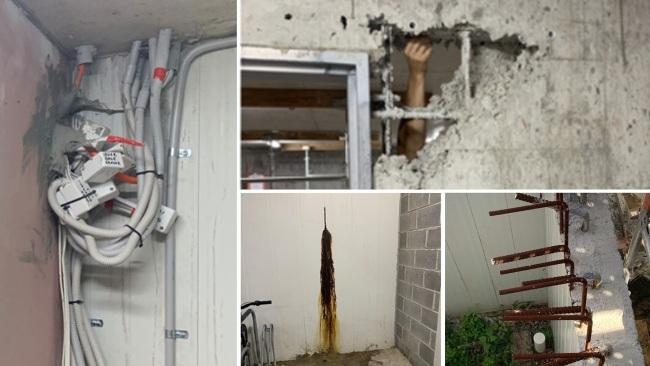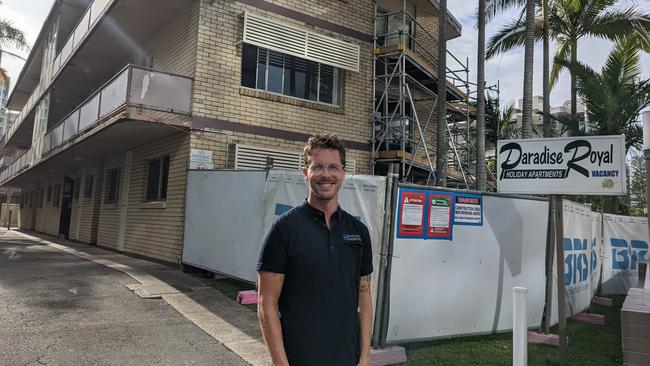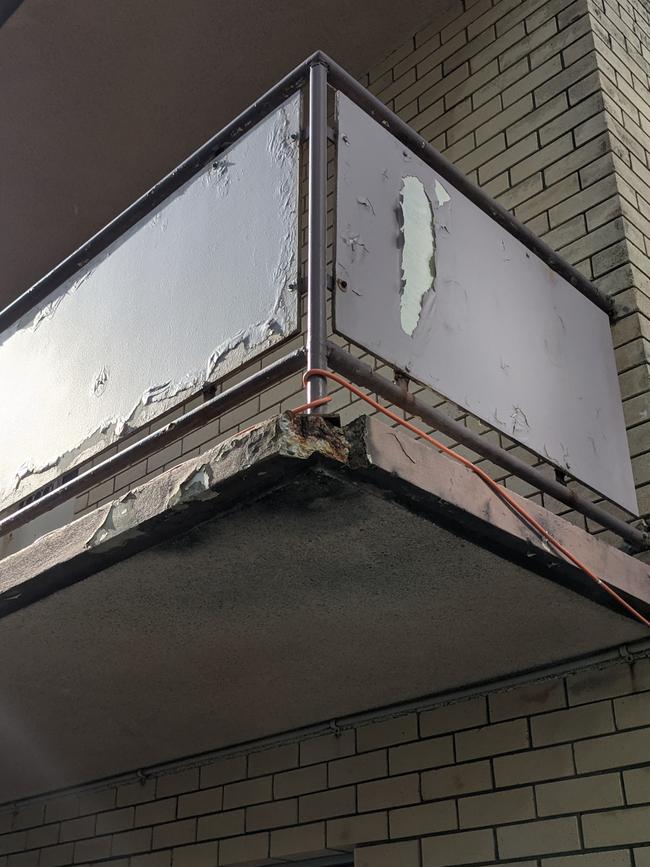NSW Building Commissioner David Chandler targets developments in Tweed Heads and Byron Bay
Developers and builders in Tweed Heads and Byron Bay have been put on notice amid reports that two in five new builds have major defects.
Gold Coast
Don't miss out on the headlines from Gold Coast. Followed categories will be added to My News.
SHONKY builders in northern New South Wales have been warned that the state’s powerful construction tsar has the area on his radar.
NSW Building Commissioner David Chandler will inspect developments in Tweed Heads and Byron Bay on Thursday during his first visit to the area since he was handed tough new powers to clean up the industry.
It comes after a shock Bulletin report showed 99 per cent of buildings inspected on the Gold Coast had some kind of defect – with experts saying the city was the “wild, wild west” for developers.
Research published by Mr Chandler’s office last month showed that 39% of strata buildings in NSW had major defects, including with waterproofing, fire safety and non compliant cladding.
Mr Chandler said developers would face tough action if serious issues were found during his visit north.
“We’ve got the most powerful legislation in the country in NSW,” Mr Chandler said. “The powers that attach to the building commissioner in NSW I believe are the envy of all the other states.
“I’ve been issuing what’s available to me under those powers.
“That includes stop work orders. That means if we see something we think should cease until someone’s got a more compliant approach. We’ve used that three times already.
“We’ve also issued 14 prohibition orders, which basically are orders that stop the issuance of an occupation certificate until we’re happy that the serious defect has been rectified.”
REVEALED: GOLD COAST'S SHONKY HOMES, APARTMENTS AND TOWERS

Mr Chandler’s crackdown comes after he was handed unprecedented powers to enter and inspect building sites under the Residential Apartment Buildings (RAB) Act 2020 following the Opal Tower and Mascot Towers debacles in Sydney.
Lobby groups including the Queensland Apartment Defects Action Group are campaigning for similar powers to be implemented north of the border.
Mr Chandler said the new powers given to him had “turned the dial” in NSW.
“In NSW we’re seeing a subsidence of those (serious defects),” he said. “For example, we think there’s been at least a 20 per cent improvement in the presence of waterproofing defects already.
“We’re seeing a substantial improvement.

“I’m finding some buildings where the developer has quietly come back and come to an agreement with the owners to vacate their building, and go back and fix their defects.
“This is costing this developer a large amount of money.
“But because they’re so invested in establishing their long-term brand, they have at their own election agreed with the owners’ corporation to vacate every person out of the building and they’re going through the building and they’re fixing all of the defects with everybody out.
“Developers are getting the message: You might have though you could get away with it in the past, but you won’t get away with it in the future.”
PREVIOUSLY: QLD THE 'WILD, WILD WEST' FOR DEVELOPERS
The boss of a company assessing buildings for defects warns the Gold Coast is the “wild, wild west” for builders and “99 per cent” of high-rises have problems that need to be fixed.
Helensvale-based Structural Diagnostics general manager Adam Husband said of more than 200 new builds and 400 older buildings inspected by his company on the Gold Coast in the last five years, only one got a clean bill of health.

Body corporates are being forced to spend millions to fix problems – including windows loose in frames, falling concrete and shaky balustrades – in complexes.
Among buildings on the Gold Coast that Mr Husband’s company has inspected recently are:
• A Main Beach high-rise being kept standing with the help of 32 titan props, which are designed to take 40 tonnes each;
• A Surfers Paradise high-rise where windows are loose in their frames;
• Another Surfers Paradise high-rise where the handrail on the balcony could be pushed over by hand;
• A Labrador high-rise where glass planes have fallen from the building;
• A Surfers Paradise building where a 10cm block of concrete fell to the ground from 11 storeys up two weeks ago, which is now being urgently fixed.
Mr Husband said most body corporates on the Gold Coast were doing the right thing and seeking to have problems rectified.
But problems were so widespread he said he was concerned the city would see cases like the Opal Tower and Mascot Towers in Sydney, which had to be evacuated due to structural concerns.
“We’re seeing hundreds of thousands of dollars worth of waterproofing that needs to be completely redone within five years of a new construction job,” he said.
“It’s just because the QBCC hasn’t had an Opal Towers yet, they’re letting it continue until we end up with an Opal Towers, or a Mascot Towers.
It’s coming for us next, that’s what I’m worried about.”
Mr Husband said concrete spalling – which involves it cracking and separating – and waterproofing were common issues, with his firm typically getting an upsurge in inquiries after storms.

He said they also saw an increase in inquiries following the partial collapse of a 40-year-old apartment building in Florida in June which killed 98 people.
“We would rather our business was not necessary. We’re ambulance chasers,” he said.
“When it rains and you get the big storms, we get the phone calls. When somebody has to spend a large amount of money to keep their building safe, we get the phone call.”
Mr Husband said even when body corporates acted to have issues fixed, repairs were often not done correctly.
“It’s not just new construction, what’s almost scarier is existing construction,” he said.
“When you look at these older buildings, they have the windows removed and we’re seeing people who are putting low-rise residential windows in high-rises.
“What you see then is that a body corporate has spent $1m to replace their windows with windows that don’t work. And then the building is actually in worse condition than it was, and it might be 30 to 40 years old at that point.
“It’s an epidemic.”

Mr Husband said windows in high-rise buildings needed to be rated to withstand greater wind and water pressure during storms.
Australian Advocacy Apartment group CEO Samantha Reece said a recent survey in New South Wales found major flaws in two of every five apartment buildings.
Ms Reece said the state government needed to urgently undertake a similar survey.
“We are very concerned by the survey in NSW commissioned by the Office of Fair Trading which showed two in five new apartment buildings have serious issues that need rectification, including fire safety and waterproofing,” she said.
“On average, the rectification bill for these works has totalled over $330,000 per apartment block and where insurance has not been claimable, owners have had to step in and foot the bill if the builder can’t or won’t pay.”
The Bulletin has also detailed revelations about Broadbeach’s Oracle building, where ratchet straps were being used to hold down a large metal structure on its rooftop.
Act early to hold developers accountable on defects
A strata law expert is urging bodies corporate to take action “as early as possible” to address defects – before they are left carrying the can for expensive rectification works.
Grace Lawyers partner Jason Carlson said: “The biggest problem I find is that bodies corporate seek advice from the right people often at the last minute. Or in some circumstances too late to take legal action for defects to be fixed.”
It was “vital” bodies corporate took action sooner rather than later, he said.
“Developers and builders will know that a poorly advised committee or a committee that receives no advice at all can just be strung along with empty promises,” he said.
“They’ll fix this, they’ll fix that, and then six years passes and all of a sudden the developer pulls up stumps.”
Mr Carlson is backing an appeal by the Queensland Apartment Defects Action Group, spearheaded by Australian Apartment Advocacy, for the Queensland Government to follow NSW after its Office of Fair Trading found 40 per cent of surveyed new apartment buildings have serious flaws.
Mr Carlson said bodies corporate had “many tools in their belts” for dealing with defect issues.
“They can go to the QBCC so they can get a direction to rectify,” he said. “Many reputable builders will comply with those directions.
“If there is non compliance, if it’s a residential development of three storeys or less, then there’s also the home warranty scheme that will protect the apartment owners by funding the expensive repair works.
“But all of these measures through the QBCC have really strict time limits.
“... A body corporate also has a subrogation right under the Body Corporate Community Management Act, where it essentially steps into the shoes of the developer under a construction contract and it can enforce any rights the developer had against the builder.
That’s completely independent of going to the QBCC.
“... So there’s a lot of tools a body corporate has in its belt, but committees often aren’t aware of these.”
Mr Carlson called for the home warranty scheme to be extended to buildings above three storeys, saying Queensland was being left behind by NSW when it came to protecting consumers. The idea is also backed by the Strata Community Association (Qld).
“In NSW they have introduced the NSW building commissioner, they’ve got their own taskforce looking closely into these issues, they’ve introduced building bonds, actual cash at the bank that could be called upon by an owners corporation if there are defects that need to be funded for repairs,” Mr Carlson said.
“The update to the strata legislation in NSW recognises the conflict of interest that a developer could have if they go onto a body corporate committee and requires that to be declared before any election occurs.
“These are all measures that have been taken in NSW that don’t exist up here in Queensland.”
More Coverage
Originally published as NSW Building Commissioner David Chandler targets developments in Tweed Heads and Byron Bay





